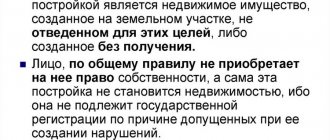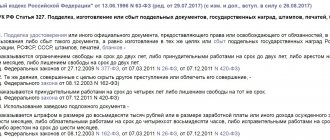ST 186 of the Criminal Code of the Russian Federation.
1. Production for the purpose of sale of counterfeit bank notes of the Central Bank of the Russian Federation, metal coins, government securities or other securities in the currency of the Russian Federation or foreign currency or securities in foreign currency, as well as storage, transportation for the purpose of sale and sale of obviously counterfeit bank notes of the Central Bank of the Russian Federation, metal coins, government securities or other securities in the currency of the Russian Federation or foreign currency or securities in foreign currency - are punishable by forced labor for a term of up to five years or by imprisonment for a term of up to eight years with a fine of in the amount of up to one million rubles or in the amount of wages or other income of the convicted person for a period of up to five years or without it.
2. The same acts, committed on a large scale, are punishable by imprisonment for a term of up to twelve years with a fine in the amount of up to one million rubles or in the amount of the wages or other income of the convicted person for a period of up to five years, or without it and with restriction of freedom for for a period of up to one year or without it.
3. Acts provided for in parts one or two of this article, committed by an organized group, are punishable by imprisonment for a term of up to fifteen years with or without a fine in the amount of up to one million rubles or in the amount of the wages or other income of the convicted person for a period of up to five years. and with or without restriction of freedom for a term of up to two years.
Commentary to Art. 186 Criminal Code
1. The subject of the crime does not include: banknotes and securities withdrawn from circulation (old coins, Soviet money abolished by monetary reforms, etc.) and having only collection value; a cash and clothing lottery ticket, since it is not a security, its counterfeit for the purpose of sale or illegal receipt of winnings is qualified as preparation for fraud.
2. The objective side is characterized by the commission of the following alternative actions: production, storage, transportation and sale of products of the crime.
3. The crime consists of both partial counterfeiting of banknotes or securities (alteration of the denomination of a genuine banknote, falsification of the number, series of a bond and other details of money and securities), and the production of completely counterfeit money and securities.
When deciding the presence or absence of a crime in a person’s actions under Art. 186 of the Criminal Code, it is necessary to establish whether banknotes, coins or securities are counterfeit and whether they have significant similarity in shape, size, color and other basic details with genuine banknotes or securities in circulation. In cases where the obvious discrepancy between a counterfeit banknote and a genuine one, which excludes its participation in money circulation, as well as other circumstances of the case, indicate the intent of the perpetrator to grossly deceive a limited number of people, such actions can be qualified as fraud (clause 3 of the Resolution of the Plenum of the Supreme Court RF dated April 28, 1994 No. 2 “On judicial practice in cases of production or sale of counterfeit money and securities”).
4. The production of counterfeit banknotes or securities is a completed crime if at least one banknote or security is manufactured for the purpose of subsequent sale, regardless of whether the sale of the counterfeit was successful.
5. The sale of counterfeit money or securities consists of using them as a means of payment when paying for goods and services, exchanging, donating, lending, selling, etc. The acquisition of obviously counterfeit money or securities for the purpose of their subsequent sale as genuine should be qualified under Art. 30 and 186 of the Criminal Code.
6. To be considered criminal, storage and transportation must be carried out for the purpose of sale, and one banknote or security can be stored and transported, regardless of whether the subsequent sale was successful.
7. Illegal acquisition by a person of someone else’s property as a result of transactions performed by him with counterfeit money or securities is covered by Art. 186 of the Criminal Code and does not require additional qualifications under the relevant articles providing for liability for theft.
8. The subjective side is characterized by direct intent. A mandatory feature of the subjective side of a crime in the form of production, storage, transportation is the presence of a sales purpose.
Commentary on Article 186 of the Criminal Code of the Russian Federation
1. Already in the first half of the 20th century. The international community has finally developed for itself the basic principles of combating such an old, if not ancient, crime as counterfeiting. The International Convention for the Suppression of Counterfeiting of Currency (1929) <1> states that all fraudulent acts in the manufacture or alteration of currency, whatever the method used to achieve it, shall be punishable as ordinary criminal offences. result; sale of counterfeit banknotes; actions aimed at selling, importing into the country or receiving or obtaining for oneself counterfeit banknotes, provided that their counterfeit nature is known; attempts to commit these offenses and acts of intentional complicity; fraudulent acts of manufacturing, receiving or acquiring for oneself instruments or other items intended by their nature for the manufacture of counterfeit banknotes or for altering banknotes. ——————————— <1> Sat. existing treaties, agreements and conventions concluded by the USSR with foreign states. Vol. VII. M., 1933. S. 40 - 53.
2. The social danger of a crime lies in the fact that this act encroaches on the foundations of economic security and financial stability of the state, the normal order of money circulation, and the full functioning of market institutions. Relations arising from the specified spheres of social activity, which are encroached upon by this act, constitute the object of a criminal attack.
2.1. The subject of the encroachment is indicated in the disposition of part 1 comment. articles are counterfeit bank notes of the Central Bank of Russia, metal coins, government securities, other securities in the currency of the Russian Federation, foreign currency, securities in foreign currency.
2.2. The crime provided for in Part 1 comment. article, belongs to the category of grave crimes, parts 2 and 3 - to the category of especially grave crimes.
3. In accordance with Part 1 of Art. 75 of the Constitution, the monetary unit in the Russian Federation is the ruble. Monetary emission is carried out exclusively by the Central Bank. The introduction and issue of other money in the Russian Federation is not permitted. The ruble is legal tender and must be accepted at face value throughout the Russian Federation. Payments on the territory of the Russian Federation are made by cash and non-cash payments (Article 140 of the Civil Code). Cash payments in the Russian Federation are carried out using CBR bank notes and metal coins.
4. The types of property recognized as currency values and the procedure for making transactions with them are determined by the Federal Law of December 10, 2003 N 173-FZ “On Currency Regulation and Currency Control” (as amended on December 30, 2006) <1>. ——————————— <1> NW RF. 2003. N 50. Art. 4859; 2004. N 27. Art. 2711; 2005. N 30 (part 1). Art. 3101; 2006. N 31 (part 1). Art. 3430; 2007. N 1 (part 1). Art. thirty.
5. Bank notes of the Central Bank, a metal coin in the currency of the Russian Federation are those in circulation, as well as those withdrawn or withdrawn from circulation, but subject to exchange, rubles in the form of bank notes (banknotes) of the Central Bank and coins.
6. The concept, types, content of securities in the Russian Federation, as well as the requirements for them, are discussed in Chapter. 7 of the Civil Code, Law on the Securities Market, Law on the Issue of Securities.
7. A security is a document certifying, in compliance with the established form and mandatory details, property rights, the exercise or transfer of which is possible only upon presentation (Article 142 of the Civil Code). Securities include: government bonds, bonds, bills of exchange, checks, deposit and savings certificates, bearer bank savings books, bills of lading, shares, privatization securities and other documents that are classified as valuable by securities laws or in the manner prescribed by them. papers (Article 143 of the Civil Code).
8. Government securities and other securities in the currency of the Russian Federation are payment documents (checks, bills, letters of credit, etc.), stock values (stocks, bonds) and other debt obligations denominated in rubles.
9. Foreign currency - banknotes in the form of banknotes, treasury notes, coins in circulation and being legal tender in the relevant foreign state or group of states, as well as banknotes withdrawn or withdrawn from circulation, but subject to exchange.
10. Securities in foreign currency are payment documents (checks, bills, letters of credit, etc.), stock values (stocks, bonds) and other debt obligations denominated in foreign currency.
11. The objective side of the crime is expressed, firstly, in the production, and secondly, in the sale of money or securities.
12. In paragraph 3 of the Resolution of the Plenum of the Armed Forces of the Russian Federation No. 2, the production of counterfeit money or securities is understood as a partial counterfeit of banknotes or securities (alteration of the denomination of a genuine banknote, counterfeiting of the number, series of a bond and other details of money and securities), and and production of completely counterfeit money and securities.
13. For correct qualification, it is necessary to establish whether banknotes, coins or securities are counterfeit and whether they have significant similarity in shape, size, color and other basic details with genuine banknotes or securities in circulation. In cases where the obvious discrepancy between a counterfeit banknote and a genuine one, which excludes its participation in money circulation, as well as other circumstances of the case, indicate the intent of the perpetrator to grossly deceive a limited number of people, such actions can be qualified as fraud (clause 3 of the Resolution of the Plenum of the Armed Forces of the Russian Federation N 2).
14. The crime is completed (by composition) if at least one banknote or security is manufactured for the purpose of subsequent sale, regardless of whether the sale of the counterfeit was successful (clause 4 of Resolution of the Plenum of the Armed Forces of the Russian Federation No. 2).
15. The sale of counterfeit money or securities consists of using them as a means of payment when paying for goods and services, exchanging, donating, lending, selling and any other method of alienation, transfer or exercise of rights under a security. Sales will constitute a complete crime already in the first case of transfer of money or securities or the exercise of rights under a security.
16. The production for the purpose of sale and sale of banknotes and securities withdrawn from circulation (coins of old mintage, Soviet money abolished by monetary reforms, etc.) and having only collection value do not form a crime under the commentary. article, and can be qualified as fraud (clause 6 of the Resolution of the Plenum of the Armed Forces of the Russian Federation No. 2).
17. To qualify the sale of counterfeit money or securities, it does not matter how this money or securities fell into the hands of the culprit. Persons who, due to a combination of circumstances, become the owners of counterfeit money or securities, who are aware of this and nevertheless use them as genuine, are subject to the MA.
18. The subjective side of the crime is characterized by guilt in the form of direct intent. The motive for qualification does not matter. The goal acts as a mandatory feature - production must pursue the goal of sales. If the purpose is not established, the person is not subject to criminal prosecution for the production of counterfeit banknotes and securities (clause 2 of Resolution of the Plenum of the Armed Forces of the Russian Federation No. 2).
19. The subject of a criminal offense is a person who has reached the age of 16.
20. Qualifying circumstances are the commission of the act specified in Part 1 on a large scale - in the amount of over 250 thousand rubles. (see note to Article 169).
21. Part 3 names the commission of a crime by an organized group as a particularly qualifying circumstance (see commentary to Article 35).
Second commentary to Art. 186 of the Criminal Code of the Russian Federation
1. The composition of the Resolution of the Plenum of the Supreme Court of the Russian Federation dated April 28, 1994 No. 2 “On judicial practice in cases of the manufacture or sale of counterfeit money or securities” applies.
2. The subject is counterfeit: bank notes of the Central Bank of the Russian Federation; metal coin; government or other securities in Russian currency or in foreign currency; foreign currency.
All of them must simultaneously possess three characteristics:
1) only money and securities in circulation, or those seized or withdrawn from circulation, but subject to mandatory exchange for money or securities in circulation, can be counterfeited;
2) money and securities must be counterfeit, i.e. fake, unreal (the method of falsification has no qualifying significance);
3) the level of counterfeiting must be quite high.
3. Counterfeit money, currency, or securities must be so similar to the real thing that they can be in circulation for at least some time. There must be significant similarity to genuine banknotes or securities in circulation in shape, size, color and other basic details. Counterfeiting money that is not in circulation, as well as having only collection value, and its subsequent sale under the guise of real money cannot be regarded as counterfeiting and entail liability under Art. 159 of the Criminal Code as fraud. Cases of sale of crudely counterfeit banknotes, when the counterfeit can be distinguished at first sight, should be assessed similarly.
4. The objective side consists of:
1) production for marketing purposes;
2) storage for sales purposes;
3) transportation for marketing purposes;
4) sale of counterfeit money or securities.
5. The crime is over when at least one counterfeit valuable banknote or coin is manufactured, stored, or transported for the purpose of subsequent sale, regardless of whether the sale of the counterfeit was successful; the sale is completed when at least one counterfeit banknote is alienated.
6. The subjective side is characterized by direct intent, and during production, storage, transportation - also by the purpose of sale and the awareness by the perpetrator of the fact that the money or securities are counterfeit.
7. Subject - a person who has reached the age of 16 years.
8. Parts 2 and 3 of the article provide for qualifying characteristics.
Contents of Art. 186 TK
At the beginning it states that the donor must be released from work by the employer on the following days:
- donating blood;
- medical examination associated with this delivery.
In a situation where the donor, by mutual agreement with the employer, began work on the day of blood donation, the employer is obliged to provide him with another day of rest. The possibility of this transfer is limited to the case where the donor works in an enterprise with hazardous conditions. In this situation, the employee who donated blood does not have the right to start work on the same day, even if he has such a desire.
The situation when blood donation occurs is separately considered:
- during the employee's vacation period;
- on a weekend/holiday.
In the mentioned options, the free day is transferred to another time.
It is also stated that after donating blood, the employer provides the donor with an additional day of rest. This day off from work, at the request of the employee himself, can be added to his allotted vacation or postponed to another date. But the period of this transfer is limited to a year from the date of the act of donation.
The final paragraph instructs the employer to retain for the donor his average earnings for days off from work associated with donating blood.
The considered article, as can be seen from its provisions, describes in detail the benefits that the employer is obliged to provide to the employee donating blood.
Judicial practice: sentences and punishment under Art. 186 of the Criminal Code of the Russian Federation
- Resolution of the Plenum of the Supreme Court of the Russian Federation dated... PLENARY OF THE SUPREME COURT OF THE RUSSIAN FEDERATION DECISION dated December 27, 2002 N 29 ON JUDICIAL PRACTICE IN CASES OF THEFT,...
- Ruling of the Constitutional Court of the Russian Federation dated March 13, 2018 N 578-O THE CONSTITUTIONAL COURT OF THE RUSSIAN FEDERATION RULING dated March 13, 2018 N 578-O ON THE REFUSAL TO ACCEPT A CITIZEN’S COMPLAINT FOR CONSIDERATION...
- Decision of the Supreme Court: Determination No. 56-КГ16-46 dated... THE SUPREME COURT OF THE RUSSIAN FEDERATION No. 56-КГ16-46 DETERMINATION Moscow March 6, 2017 Judicial Collegium for Civil Cases of the Supreme Court...
- Decision of the Supreme Court: Determination No. 56-КГ16-46 dated... THE SUPREME COURT OF THE RUSSIAN FEDERATION No. 56-КГ16-46 DETERMINATION Moscow March 6, 2017 Judicial Collegium for Civil Cases of the Supreme Court...
- Resolution of the Plenum of the Supreme Court of the Russian Federation dated... PLENARY OF THE SUPREME COURT OF THE RUSSIAN FEDERATION DECISION of November 15, 2021 N 48 ON THE PRACTICE OF APPLICATION BY COURTS OF LEGISLATION GOVERNING FEATURES...
- Resolution of the Plenum of the Supreme Court of the Russian Federation dated... PLENAUM OF THE SUPREME COURT OF THE RUSSIAN FEDERATION DECISION dated June 25, 2021 N 18 ON JUDICIAL PRACTICE IN CASES OF CRIMES,...
- Ruling of the ECtHR dated 02/14/2017 EUROPEAN COURT OF HUMAN RIGHTS THIRD SECTION CASE “MASLOVA VS. RUSSIAN FEDERATION” (Complaint No. 15980/12) JUDGMENT…
- Resolution of the Presidium of the Supreme Court of the Russian Federation dated... PRESIDIUM OF THE SUPREME COURT OF THE RUSSIAN FEDERATION DECISION dated December 5, 2018 N 126-P18 ON RESUMING PROCEEDINGS IN THE CASE DUE TO NEW...
- Resolution of the Plenum of the Supreme Court of the Russian Federation dated... PLENAUM OF THE SUPREME COURT OF THE RUSSIAN FEDERATION DECISION dated December 17, 2021 N 43 ON SOME ISSUES OF JUDICIAL PRACTICE IN CASES...
- Decision of the Supreme Court: Resolution No. 310P13 dated... DECISION OF THE PRESIDIUM OF THE SUPREME COURT OF THE RUSSIAN FEDERATION Case No. 310-P13 Moscow January 23, 2014 Presidium of the Supreme Court of the Russian Federation...






